Biography
He was a member of the Medieval noble family Van der Duyn (nl). He joined the army of the Dutch Republic as lieutenant,after completing his military education,in 1787. From 1789 till 1791 he studied Roman law at the University of Leiden. At the age of 20 he became Chamberlain of Prince William Frederick,the son of stadtholder William V. He belonged to the Orange party that opposed the more liberal Patriots who wanted to curtail the power of the stadtholder. However,Van de Duyn was quite enlightened and didn't belong to reactionary wing of the Orange party. After the French occupation of the Dutch Republic and the establishment of the Batavian Republic,he retired from public service and devoted himself to study. He rented the Castle of IJsselstein and lived there with his wife Maria Baroness van der Capellen,who he had married in 1799. They were a very happy young couple,but Maria passed away after ten years of marriage. Van der Duyn was fond of literature and had his own private library. He preferred to read the works of Diderot,Rousseau,Bayle,Belle van Zuylen and Goethe. He was influenced by the liberal ideas of his age. He preferred a Constitutional Monarchy and was opposed to tyranny. He did sympathize with some of the ideals of the French revolutionaries,but despised the radicalism of the Jacobins. He seldom left his castle and choose to live a quiet life.
In 1811 Van der Duyn moved to The Hague. He joined the circle of conspirators around Gijsbert Karel van Hogendorp who were planning an uprising against the French occupators. In November 1813,when it came clear that Emperor Napoleon was losing the war against the Coalition,Van der Duyn,Van Hogendorp and Leopold van Limburg Stirum took power after an uprising which was planned carefully,and formed a Triumvirate that invited Prince William Frederick,the son of the last stadtholder,to come to the Netherlands and to accept the title of Sovereign Prince. On 30 November 1813 Prince William Frederick landed at Scheveningen. After the return of Prince William,a commission was set up to draft a Constitution. Van der Duyn was made a member of that commission that was headed by Van Hogendorp. In 1814 he was appointed a member of the Raad van State (Council of State). Besides that,he also became head of the Royal Household.
As a nobleman (predicate: Jonkheer ,squire),he was entitled to join the Ridderschap ,the College of Knights,of South Holland. When Prince William Frederick accepted the throne as King William I,Van der Duyn was given the title Count.
From 1817 till 1844 Van der Duyn served as governor of South Holland. King William made him Marshal of the Court in 1825. He continued to serve as Marshal of the Court under William II,who succeeded his father in 1840. In 1840s he supported the revision of the Constitution. In 1848 the King appointed Van der Duyn a member of the Senate in order to secure a majority for the constitutional revisions. He died shortly afterwards on 19 December 1848 in The Hague.

William I was a Prince of Orange, the King of the Netherlands and Grand Duke of Luxembourg.

William III, also widely known as William of Orange, was the sovereign Prince of Orange from birth, Stadtholder of Holland, Zeeland, Utrecht, Guelders, and Overijssel in the Dutch Republic from the 1670s, and King of England, Ireland, and Scotland from 1689 until his death in 1702. As King of Scotland, he is known as William II. He is sometimes informally known as "King Billy" in Ireland and Scotland. His victory at the Battle of the Boyne in 1690 is commemorated by Unionists, who display orange colours in his honour. He ruled Britain alongside his wife and cousin Queen Mary II, and popular histories usually refer to their reign as that of "William and Mary".

The Batavian Republic was the successor state to the Republic of the Seven United Netherlands. It was proclaimed on 19 January 1795 and ended on 5 June 1806, with the accession of Louis I to the Dutch throne. From October 1801 onward, it was known as the Batavian Commonwealth. Both names refer to the Germanic tribe of the Batavi, representing both the Dutch ancestry and their ancient quest for liberty in their nationalistic lore.

In the Low Countries, stadtholder was an office of steward, designated a medieval official and then a national leader. The stadtholder was the replacement of the duke or count of a province during the Burgundian and Habsburg period.

The House of Orange-Nassau is the current reigning house of the Netherlands. A branch of the European House of Nassau, the house has played a central role in the politics and government of the Netherlands and Europe especially since William the Silent organised the Dutch Revolt against Spanish rule, which after the Eighty Years' War (1568–1648) led to an independent Dutch state.
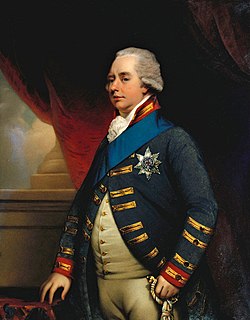
William V was a prince of Orange and the last stadtholder of the Dutch Republic. He went into exile to London in 1795. He was furthermore ruler of the Principality of Orange-Nassau until his death in 1806. In that capacity he was succeeded by his son William.

Amsterdam is the capital of the Netherlands according to the Constitution of the Netherlands, although the States General and the Executive Branch have been situated in The Hague since 1588, along with the Supreme Court and the Council of State. Since the 1983 revision of the Constitution of the Netherlands, Article 32 mentions that "the King shall be sworn in and inaugurated as soon as possible in the capital city, Amsterdam". It is the only reference in the document stating that Amsterdam is the capital. In contrast, The Hague is customarily called the residentie (‘residence’).

William IV was Prince of Orange from birth and the first hereditary Stadtholder of all the United Provinces of the Netherlands from 1747 till his death in 1751. During his whole life he was furthermore ruler of the Principality of Orange-Nassau within the Holy Roman Empire.

Prince of Orange is a title originally associated with the sovereign Principality of Orange, in what is now southern France and subsequently held by sovereigns in the Netherlands.
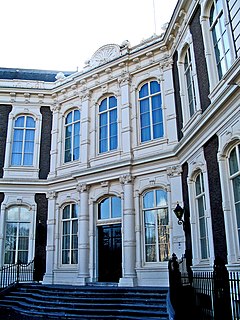
The Council of State is a constitutionally established advisory body in the Netherlands to the government and States General that officially consists of members of the royal family and Crown-appointed members generally having political, commercial, diplomatic or military experience. It was founded in 1531, making it one of the world's oldest still-functioning state organisations.

Princess Wilhelmina of Prussia was the consort of William V of Orange and the de facto leader of the dynastic party and counter-revolution in the Netherlands. She was the daughter of Prince Augustus William of Prussia and Luise of Brunswick-Wolfenbüttel. Wilhelmina was the longest-serving Princess consort of Orange.

Gijsbert Karel, Count van Hogendorp was a liberal conservative and liberal Dutch statesman. He was the brother of Dirk van Hogendorp the elder and the father of Dirk van Hogendorp the younger.
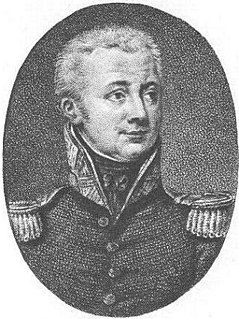
Leopold Count van Limburg Stirum was a politician who was part of the Triumvirate that took power in 1813 in order to re-establish the monarchy in the Netherlands.

Hendrik George, Count de Perponcher Sedlnitsky was a Dutch general and diplomat. He commanded the 2nd Netherlands Division at the Battle of Quatre Bras and the Battle of Waterloo.
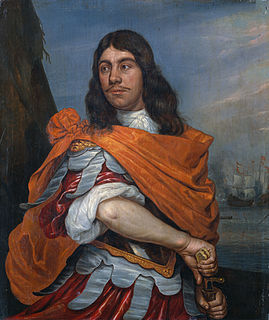
In the history of the Dutch Republic, Orangism or prinsgezindheid was a political force opposing the Staatsgezinde (pro-Republic) party. Orangists supported the Princes of Orange as Stadtholders and military commanders of the Republic, as a check on the power of the regenten. The Orangist party drew its adherents largely from traditionalists – mostly farmers, soldiers, noblemen and orthodox Catholic and Protestant preachers, though its support fluctuated heavily over the course of the Republic's history and there were never clear-cut socioeconomic divisions.
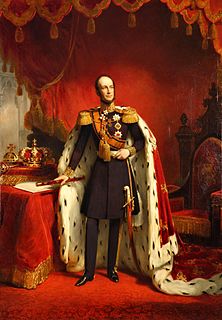
William II was King of the Netherlands, Grand Duke of Luxembourg, and Duke of Limburg.

The Triumvirate of 1813 formed the provisional government of the Netherlands after Charles-François Lebrun and the French troops had left the country. It consisted of Gijsbert Karel van Hogendorp, Frans Adam van der Duyn van Maasdam and Leopold of Limburg Stirum. Proclaimed by declaration on 20 November 1813, the three statesmen invited the almost forgotten Prince William Frederick of Orange-Nassau to The Hague to prevent anarchy or a possible annexation of the Netherlands by Prussia or England. William Frederick arrived in Scheveningen on 30 November and accepted sovereignty of the newly established Sovereign Principality of the United Netherlands on 2 December 1813. The Triumvirate, having completed its objective, was disestablished on 6 December. William Frederick would go on to become the first King of the Netherlands as William I in 1815.

The Sovereign Principality of the United Netherlands was a short-lived sovereign principality and the precursor of the United Kingdom of the Netherlands, in which it was reunited with the Southern Netherlands in 1815. The principality was proclaimed in 1813 when the victors of the Napoleonic Wars established a political reorganisation of Europe, which would eventually be defined by the Congress of Vienna.

The Incorporation is a period in Dutch history where the country was part of the First French Empire. This period lasted from July 9 1810 until November 21 1813.



















